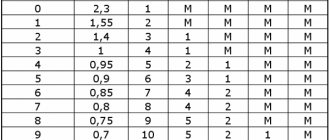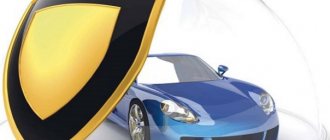In the event of an accident, the compulsory motor liability insurance policy must protect the culprit of the accident from financial losses and guarantee the injured driver compensation for damages. Practice, including judicial practice, shows that this is not so; previously, the compulsory motor liability insurance policy protected only the culprit of the accident, not allowing the victim to receive full compensation for damage, and on March 10, 2021, the Constitutional Court of the Russian Federation issued Resolution No. 6-P, which amends procedure for compensation of losses in case of accidents, now the law on compulsory motor liability insurance is not only not aimed at protecting the interests of the victim in an accident, but protects exclusively the interests of insurance companies!
What changed?
Within the framework of compulsory motor liability insurance, damage sustained in an accident was assessed taking into account the wear of components (with the exception of certain groups). The amount calculated by the insurer usually did not cover all the costs of repairing the car. If, during the assessment, it turned out that the repairs would cost an amount that exceeds the compensation limit under compulsory motor liability insurance, the difference was recovered from the culprit of the accident. The wear and tear of spare parts was also taken into account and the victim was forced to look for used spare parts to repair his car.
In March 2017, the Constitutional Court ruled that when recovering damages from the driver responsible for an accident, the degree of wear and tear of components should not be taken into account. The compensation amount includes the cost of new spare parts and actual expenses incurred. In this case, the insurer compensates for the damage as before, calculating the amount of payment according to the Unified Methodology (should be read “according to the curved RSA reference books”) and also taking into account the degree of wear and tear.
The consequences of this decision of the Constitutional Court are clearly negative for all participants in the accident, except for insurers:
- The burden of compensation for losses falls to a greater extent on the culprit of the accident (whose motor vehicle liability should be protected by a compulsory motor liability insurance policy). The insurance company compensates for damage according to the Unified Methodology of the Central Bank of the Russian Federation, taking into account the wear and tear of components (with a cash payment). In case of in-kind compensation, the compensation limit under MTPL continues to apply. If the car owner injured in an accident is not satisfied, he cannot make financial claims to the insurer, but is forced to contact the person responsible for the accident, without taking into account the wear and tear of components. For example, if a 20-year-old foreign car has a rusty fender that needs to be replaced, the defendant will have to pay the cost of a new body part;
- For injured drivers, obtaining compensation becomes more difficult. You can only demand compensation for damages from the person responsible for the accident through the court. Financial claims must be justified by assessing the damage and calculating the cost of restoration repairs. Even if the court rules in favor of the plaintiff, there is no guarantee that the victim will receive compensation—enforcement proceedings can drag on for years.
Official website of the Supreme Court of the Russian Federation
If the insurer refused to send the car for repairs, and the court decided that he should have done this, then the victim must receive the entire amount of damage without taking into account the wear and tear of the car. The Supreme Court came to this conclusion when considering a dispute between an insurance company and a car owner.
So, another car ran into the stationary car of a certain Sailyan. The guilt of the second was established. Sailyan turned to his insurer for direct payment. The insurer organized an inspection of the car, based on the results of which a specialist drew up a report. The report stated that the amount of damage from a technical point of view does not correspond to the stated events and was received under other circumstances. On this basis, the insurer refused to send for repairs or pay insurance compensation.
The victim conducted an independent assessment and then submitted a claim to the insurer, the insurer repeated its refusal on the same grounds. Then Sailyan went to court with a request to recover insurance compensation in the amount of 346,300 rubles, a penalty, a fine, etc.
The district court ordered a forensic auto-technical examination. According to her conclusion, some of the damage to the car corresponds to the stated collision mechanism. The cost of restoration of the plaintiff’s car for damage received in this accident, in accordance with the Unified Methodology for determining the amount of costs for restoration repairs approved by the Central Bank, is 346,300 rubles without taking into account wear and tear, and 256,500 rubles taking into account wear and tear. The district court recovered from the insurer the amount without taking into account depreciation, as well as a fine of 100,000 rubles, a penalty until the court hearing in the amount of 100,000, compensation for moral damage (1,000 rubles), as well as legal expenses.
In addition, a penalty was collected from the insurer in favor of the victim for each day of delay until the day of actual execution of the court decision, but not more than 300 thousand.
The appeal court, to which the insurer appealed, upheld this decision. However, the Second Court of Cassation overturned the ruling of the appeal court and sent the case for a new trial, indicating that the insurance compensation was collected in monetary terms, and therefore, the amount of expenses for spare parts should be determined taking into account wear and tear. Sailyan appealed this decision to the Supreme Court.
And the Supreme Court indicated that according to the law on compulsory motor liability insurance, the insurer, after inspecting the car or conducting an independent technical examination, issues a referral to the victim for repairs and pays the cost of restoration repairs. In this case, the cost of such repairs is paid without taking into account the wear and tear of components.
The list of cases when insurance compensation, at the choice of the victim, by agreement between the victim and the insurer, or due to objective circumstances, instead of organizing and paying for restoration repairs, is carried out in the form of an insurance payment, is established by the law on compulsory motor liability insurance.
The insurer did not send the car for repairs, so it must compensate for its cost
The courts have not established the circumstances under which the insurance company had the right to replace the organization and payment for restoration repairs with an insurance payment without the consent of the victim.
The insurer did not fulfill its obligations to organize restoration repairs, and therefore must compensate the victim for the cost of such repairs without taking into account wear and tear of components. Therefore, the Supreme Court overturned the previous decisions and sent the case for a new trial to the Second Court of Cassation.
This is a new word in judicial practice, which, of course, is more profitable for car owners. It will cost insurers more to refuse their obligations.
Text: Vladimir Barshev
Rossiyskaya Gazeta - Federal Issue No. 29 (8380)
Where does the Constitutional Court resolution of March 10, 2017 apply?
Insurance companies began to use this regulation in droves. If a car insured under CASCO is damaged in an accident, then insurers forget about recent savings, show loyalty to their policyholder, and with unprecedented ease send such cars, regardless of their age, to dealerships. Where they are repaired at inflated (compared to regular service stations) prices. And after some time, they bring a claim against the culprit of the accident*, demanding additional payment of the difference between the payment under compulsory motor liability insurance and the actual repair, even if the damage does not exceed the insurance company’s payment limit.
Let's give an example: the damaged Toyota Land Cruiser 200, manufactured in 2014, is insured under CASCO and received damage in the form of a broken front bumper, which needs to be replaced. Repairs at a dealer station will cost approximately 45 thousand rubles. The cost of the bumper at the dealer is about 33 thousand and the replacement and painting work is about 12 thousand. The compensation payment under compulsory motor liability insurance will be approximately 11-12 thousand rubles. Bumper according to the RSA directory - 6 thousand rubles (minus wear - 30-40 percent), 4 thousand rubles remain, replacement and painting work according to the Unified Methodology is approximately 7 thousand rubles. This means the culprit must pay extra. Attention!!! 45-11=34 thousand rubles! And most importantly - everything is according to the law!!!
A reasonable question arises: Why is such insurance needed?
At the moment, we are not able to answer it.
Is depreciation always taken into account when paying under compulsory motor liability insurance?
| This was followed by long proceedings in the courts of several instances: first, appellate and in the Federal Arbitration Court of the West Siberian District. All these courts sided with NSG Rosenergo, that is confirmed the need for payment under compulsory motor liability insurance taking into account wear and tear. It should be noted that they also did not even recognize the right of the National Insurance Group to subrogate at least some amount. Therefore, in the end, the NSG appealed to the Supreme Arbitration Court. After the trial, this respected organization satisfied the plaintiff’s claims on both counts: on subrogation itself (which is quite natural) and on compensation in the amount of 81,204.73 rubles. (those. actually payment taking into account wear and tear!). Your motivation is extremely interesting. I am not a professional lawyer, but nevertheless I found obvious weaknesses in it, which I will now show. Recognizing the existence of Article 63, the Supreme Arbitration Court draws attention to the fact that the Law on Compulsory Motor Liability Insurance and the Civil Code, as legislative acts of a higher level, take precedence over the Rules. This is understandable and reasonable. However, where in these acts is it written that payment under compulsory motor liability insurance should occur without taking into account wear and tear? |
YOU “found” such places.
Here's how it is justified (quotes from the reasoning part of the decision)
The main goals and principles of the Federal Law of April 25, 2002 No. 40-FZ are the protection of the rights of victims to compensation for harm caused to their life, health and property, the inadmissibility of worsening the situation of the victim and reducing the guarantees established by the Law of his rights to compensation for harm when using vehicles by other persons .
To implement these goals and principles, the said Law establishes the amount of the insurance amount (Article 7 of the Law), within which the victim has the right to demand an insurance payment under compulsory insurance (Article 13 of the Law)
What follows is an unexpected conclusion:
Federal Law No. 40-FZ of April 25, 2002 does not provide for restrictions on insurance payments in connection with the condition in which the property was at the time of damage.
Such a restriction would be contrary to the provision of civil law on full compensation for losses resulting from damage to the property of the victim, since the need for expenses that he will have to make to restore the property is caused by the harm caused.
I wonder what Law our judges read? Due to my profession, I have repeatedly studied the Law on Compulsory Motor Liability Insurance. So, Article 12 Determination of the amount of insurance payment in paragraph 2.1. says directly:
The amount of damages subject to compensation in case of damage to the property of the victim is determined: b) in the case of damage to the property of the victim - in the amount of expenses necessary to bring the property to the state in which it was before the occurrence of the insured event.
In the wording “full compensation for losses”, YOU obviously got caught up in the adjective “full”, forgetting about the noun “loss”.
The definition of damages is given in Art. 15 of the Civil Code of the Russian Federation: Losses are understood as
expenses that a person whose right has been violated has made or will have to make to restore the violated right, loss or damage to his property (real damage), as well as lost income that this person would have received under normal conditions of civil circulation if his right were not was violated (lost profits).
That is, loss, real damage, loss is what you had before the accident minus what you had left after the accident. If you install the same hundred-year-old door during repairs on your conditional hundred-year-old Zaporozhets, exactly the same as it was, will your right be restored? Obviously, yes - your property will be returned to “the condition in which it was before the occurrence of the insured event.”
But it’s unlikely that repairmen will have such a door, the wear of which is equal to the wear of your car. Therefore, they will install a new one, but this will no longer be a “restoration” , but an improvement compared to what it was before the accident, right?
Such a blunder by such a professional body as the Supreme Arbitration Court is not surprising in the Russian conditions of the complete destruction of the judicial system. Obviously, the main problem for the court was in proving subrogation - the decision talks about this no less than wear and tear. And since, in the opinion of the court, the right of claim should be transferred in full (81,204.73, and not 74,463), then the court adjusted the topic with wear and tear to this opinion.
So, alas, this is called “much ado about nothing.”
I myself believe that it will be more convenient for everyone to pay under compulsory motor liability insurance, as under most CASCO programs - that is, without taking into account wear and tear. However, this must be clearly confirmed by law. As for tariffs - I don’t think that even in this situation they will need to be increased - the stock of insurance under compulsory motor liability insurance is still quite large.
With all respect, Andrew.
How to act correctly?
If you are not at fault for the accident. The procedure is standard: after an accident, you need to contact the insurance company, assess the damage, and receive compensation. If the compensation does not cover the actual costs of repairs, evidence of this will be needed (an estimate of the actual damage, documents from the insurance company, etc.). Financial claims must be adequate. If the amount of damage claimed by the plaintiff is greater than the cost of the entire car (if we are talking about an old car, for example), the claim will most likely be denied.
If you are at fault in an accident. It is advisable to record the actual damage to the second car (take a photo at the scene of the accident). If, when compensating for damage by the insurer, the amount of compensation was less than the limit provided for by compulsory motor liability insurance, the insurer is brought in as a co-defendant. The defendant may also offer his own methods of compensation for the damage caused, for example, full-scale repair of the damaged car. This should be used if the financial claims are greatly inflated, and for an old foreign car the plaintiff demands, for example, repairs at a dealership.
carries out assessments of damage caused to cars in road accidents, we employ auto lawyers, we effectively protect the financial and legal interests of car owners.
How to calculate car depreciation
When estimating the value of a car, the question arises, how to calculate the depreciation of a car? The formula for calculating depreciation of a car and the online calculator help to more accurately calculate the depreciation of a car.
Over time, every car becomes cheaper, the price decrease occurs due to physical and moral wear and tear. Physical wear and tear is a measure of the obsolescence of parts, components, and bodywork. It is affected by the intensity of use, environmental pollution, and climate.
If you use the car for its intended purpose, productive wear and tear occurs. If the car is parked in a garage, then physical wear and tear still occurs, but it is called unproductive.
Obsolescence occurs due to obsolescence of technology and the release of new car models with improved qualities. The monetary expression of physical and moral wear and tear is called depreciation.
In accounting, depreciation calculation is needed to write off the cost of the car and maintenance costs in parts. If you write off a lump sum at the end of using the machine, you will see a loss on your balance sheet.
In order to evenly account for the profit from the operation of the machine and the loss from wear and tear and operating costs, depreciation is calculated at intervals of once a month or a year. This reduces the tax base.
Calculating car depreciation is also useful for the vehicle owner. For example, if the work involves driving, and the company compensates for part of the costs and wear and tear.
The calculation will be needed to sell and buy a car, to understand the actions of appraisers in car pawnshops, insurance companies, and banks. This will allow you to understand how the process works and estimate the order of payment amounts.
Accounting for wear of parts to be replaced when repairing a car at a service station
If insurance compensation is carried out in the form of organizing and paying for the restoration repair of a damaged vehicle at a service station, then the cost of restoration repair of a car owned by a citizen and registered in the Russian Federation is determined without taking into account the wear and tear of parts, components, and assemblies.
The Supreme Court explained that, as a general rule, it is not allowed to use used or refurbished components, parts and assemblies when repairing a car, unless the parties have mutually agreed on this.
Explanations of the Supreme Court of the Russian Federation:
In contrast to the general rule, payment for the cost of restoration of a passenger car owned by a citizen (including those with individual entrepreneur status) and registered in the Russian Federation is carried out by the insurer without taking into account the wear and tear of components (parts, assemblies, assemblies) (paragraph three of clause 15.1 of article 12 Law on compulsory motor liability insurance as amended by the Federal Law of March 28, 2021 N 49-FZ).
If, in accordance with the Methodology, replacement of components is required..., then during the restoration of a damaged vehicle, the use of used or refurbished components is not allowed... Otherwise can only be determined by agreement between the insurer and the victim (paragraph three of clause 15.1 of article 12 of the MTPL Law) ( see for more details paragraph 59 of the Resolution of the Plenum of the Supreme Court of the Russian Federation dated December 26, 2017 N 58).
0
Author of the publication
offline 12 hours
What is depreciation?
Depreciation according to OSAGO is the depreciation of vehicle spare parts received during its operation. This parameter is used by insurers to reduce payments under insurance policies and is legal. The thing is that in the event of an accident, most of the car’s spare parts are not new, which means that their market value before the accident is lower than that of a new car (read about how to calculate the cost of spare parts according to compulsory motor liability insurance on the RSA website). As a result, when calculating the insurance payment, insurers do not pay 100% of the average market value of the part, but somewhat less.










